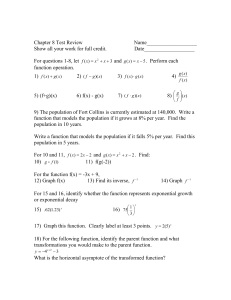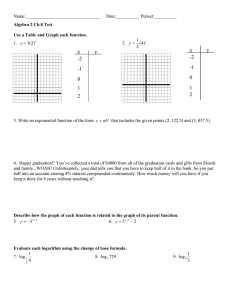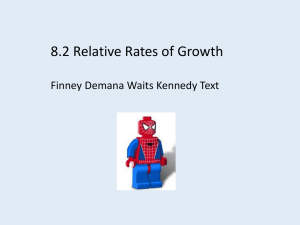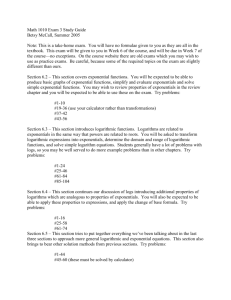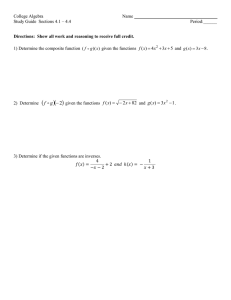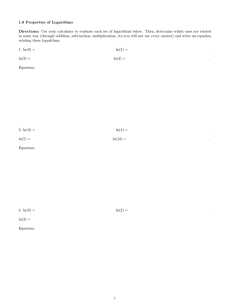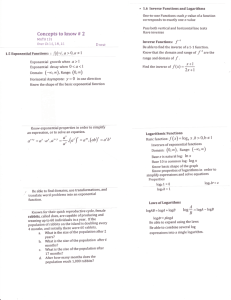1
advertisement
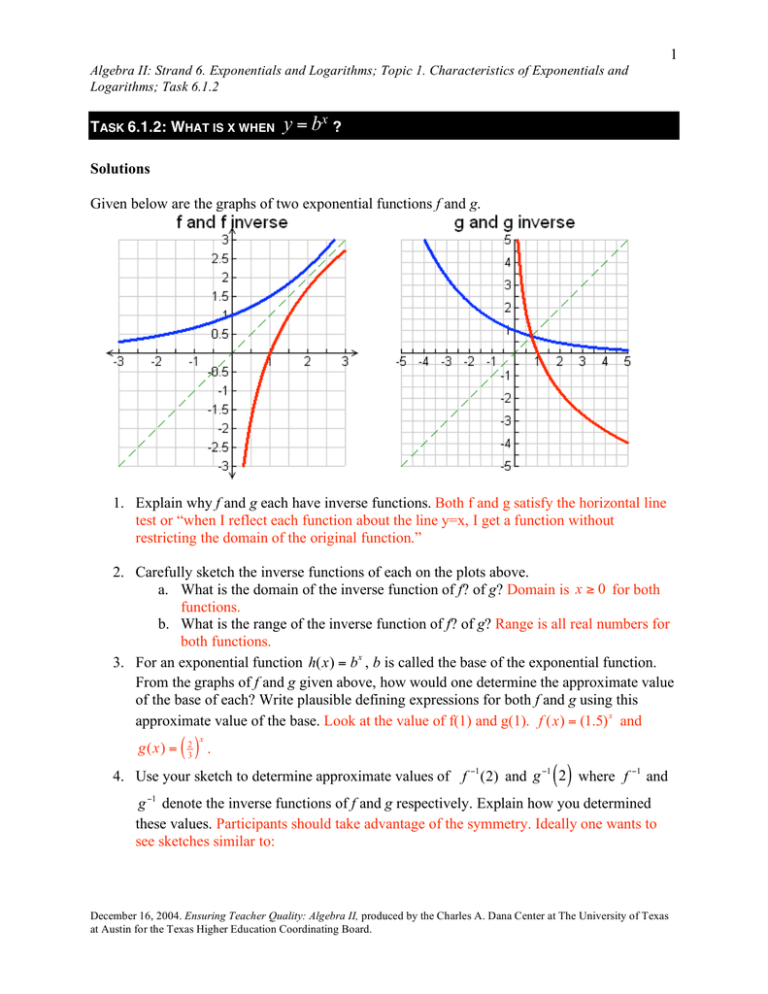
1 Algebra II: Strand 6. Exponentials and Logarithms; Topic 1. Characteristics of Exponentials and Logarithms; Task 6.1.2 TASK 6.1.2: WHAT IS X WHEN y = bx ? Solutions Given below are the graphs of two exponential functions f and g. 1. Explain why f and g each have inverse functions. Both f and g satisfy the horizontal line test or “when I reflect each function about the line y=x, I get a function without restricting the domain of the original function.” 2. Carefully sketch the inverse functions of each on the plots above. a. What is the domain of the inverse function of f? of g? Domain is x ! 0 for both functions. b. What is the range of the inverse function of f? of g? Range is all real numbers for both functions. 3. For an exponential function h(x) = bx , b is called the base of the exponential function. From the graphs of f and g given above, how would one determine the approximate value of the base of each? Write plausible defining expressions for both f and g using this approximate value of the base. Look at the value of f(1) and g(1). f (x) = (1.5) x and g(x) = () 2 3 x . () 4. Use your sketch to determine approximate values of f !1 (2) and g !1 2 where f !1 and g !1 denote the inverse functions of f and g respectively. Explain how you determined these values. Participants should take advantage of the symmetry. Ideally one wants to see sketches similar to: December 16, 2004. Ensuring Teacher Quality: Algebra II, produced by the Charles A. Dana Center at The University of Texas at Austin for the Texas Higher Education Coordinating Board. 2 Algebra II: Strand 6. Exponentials and Logarithms; Topic 1. Characteristics of Exponentials and Logarithms; Task 6.1.2 5. Explain why determining the value of f !1 (2) is equivalent to asking the question: “what is x when f (x) = 2 ?” or “what is x when 2 = bx (where b is the base of the exponential function f)?” Participants should refer to the symmetry in their graph or they could also f !1 2 state that 2 = "# f o f !1 $% 2 = b ( ) 6. Think about the following question: “What is x when 10 x = 36 ?” There are several ways to investigate this question. We could begin by finding an interval that contains the solution. That is, we can easily calculate 101 = 10 and 102 = 100 and this would help us determine that the solution is between 1 and 2. Also, since 101.5 ! 31.6 we could say that 1.5<x<2. We can continue this process to determine an approximate value for x. Use this method for estimating the approximate value of x to the nearest thousandth for the following: () Estimates Using Guess-and-Check 10 x = 36 x ! 1.556 10 x = 50 x ! 1.699 10 x = 3 x ! .477 10 x = 125 x ! 2.097 10 x = 220 x ! 2.342 December 16, 2004. Ensuring Teacher Quality: Algebra II, produced by the Charles A. Dana Center at The University of Texas at Austin for the Texas Higher Education Coordinating Board. 3 Algebra II: Strand 6. Exponentials and Logarithms; Topic 1. Characteristics of Exponentials and Logarithms; Task 6.1.2 7. Determine a graphical method for obtaining estimates for the solutions. Explain your method. For example, for the first entry participants may use the following: 8. Using the LOG key, find each of the following values to the nearest thousandth. 9. log 36 = 1.556 log50 = 1.699 log 3 = .477 log125 = 2.097 log 220 = 2.342 Compare the values in the tables from Exercises 6, 7, and 8. a. Explain what the calculator displays when the LOG key is used. For example, log 36 is the solution to 10 x = 36 . That is, log c is the solution to 10 x = c for a given c>0. b. Without using your calculator, answer the following. i. If 101.653 = 45 , what is log 45 ? 1.653 ii. If log132 = 2.121 , what is 102.121 ? 132 iii. log104 = 4 iv. 10log1000 = 1000 10. LOG on your calculator is short for common logarithm. Give the exponential function for which the common logarithm function is the inverse function. Explain your reasoning. Based upon the tables for powers of 10 and the relationship correspondence with the tables for LOG we conclude that the base of the exponential function for which LOG is the inverse function is 10. Observe that in iii and iv of Exercise 9 it is easier to see that if we compose the two functions we get the identity function. 11. Can a common logarithm of a real number be negative? If so, give an example. If not, explain why not. Yes, if the number is between 0 and 1. Encourage participants to see this graphically. December 16, 2004. Ensuring Teacher Quality: Algebra II, produced by the Charles A. Dana Center at The University of Texas at Austin for the Texas Higher Education Coordinating Board. 4 Algebra II: Strand 6. Exponentials and Logarithms; Topic 1. Characteristics of Exponentials and Logarithms; Task 6.1.2 12. Do negative numbers have common logarithms? If so, give an example. If not explain why not. No, the domain of the common logarithm is equivalent to the range of the exponential function, which is 0,! ( ) Math notes The approach developed here emphasizes the fact that exponential functions of base b and logarithm functions of base b are inverse functions. Teaching notes This task can be done with little direct coaching by the leader. It is important to circulate as the students work in groups to ensure that they are using a qualitative approach (rather than button-pushing) to working the exercises. For example, in Exercise 4 ask participants to show how they obtain their solution graphically. In Exercise 6, the process they are using is a bisection method. The leader may have to clarify the next step of the process (that is choose the midpoint of the interval that contains x) if participants do not develop this on their own. Technology notes In Exercise 7, participants need to be reminded to choose a friendly viewing window. Also, the leader may need to review how to find the intersection of two curves on the graphing calculator. December 16, 2004. Ensuring Teacher Quality: Algebra II, produced by the Charles A. Dana Center at The University of Texas at Austin for the Texas Higher Education Coordinating Board. 5 Algebra II: Strand 6. Exponentials and Logarithms; Topic 1. Characteristics of Exponentials and Logarithms; Task 6.1.2 TASK 6.1.2: WHAT IS X WHEN y = bx? Given below are the graphs of two exponential functions f and g. 1. Explain why f and g each have inverse functions. 2. Carefully sketch the inverse functions of each on the plots above. a. What is the domain of the inverse function of f? of g? b. What is the range of the inverse function of f? of g? x 3. For an exponential function h(x) = b , b is called the base of the exponential function. From the graphs of f and g given above, how would one determine the approximate value of the base of each? Write plausible defining expressions for both f and g using this approximate value of the base. 4. Use your sketch to determine approximate values of f g !1 ( 2 ) and g ( 2 ) where !1 f !1 and !1 denote the inverse functions of f and g respectively. Explain how you determined these values. December 16, 2004. Ensuring Teacher Quality: Algebra II, produced by the Charles A. Dana Center at The University of Texas at Austin for the Texas Higher Education Coordinating Board. 6 Algebra II: Strand 6. Exponentials and Logarithms; Topic 1. Characteristics of Exponentials and Logarithms; Task 6.1.2 5. Explain why determining the value of f !1 ( 2 ) is equivalent to asking the question: x “what is x when f (x) = 2 ?” or “what is x when 2 = b (where b is the base of the exponential function f)?” x 6. Think about the following question: “What is x when 10 = 36 ?” There are several ways to investigate this question. We could begin by finding an interval that contains the 1 2 solution. That is, we can easily calculate 10 = 10 and 10 = 100 and this would help 1.5 us determine that the solution is between 1 and 2. Also, since 10 ! 31.6 we could say that 1.5<x<2. We can continue this process to determine an approximate value for x. Use this method for estimating the approximate value of x to the nearest thousandth for the following: Estimates Using Guess-and-Check 10 x 10 x 10 x 10 x 10 x = 36 = 50 =3 = 125 = 220 x! x! x! x! x! 7. Determine a graphical method for obtaining estimates for the solutions. Explain your method. Estimates Using Graphing Technique 10 x 10 x 10 x 10 x 10 x = 36 = 50 =3 = 125 = 220 x! x! x! x! x! December 16, 2004. Ensuring Teacher Quality: Algebra II, produced by the Charles A. Dana Center at The University of Texas at Austin for the Texas Higher Education Coordinating Board. 7 Algebra II: Strand 6. Exponentials and Logarithms; Topic 1. Characteristics of Exponentials and Logarithms; Task 6.1.2 8. Using the LOG key, find each of the following values to the nearest thousandth. log 36 = log 50 = log 3 = log125 = log 220 = 9. Compare the values in the tables from Exercises 6, 7, and 8. c. Explain what the calculator displays when the LOG key is used. d. Without using your calculator, answer the following. 1.653 i. If 10 = 45 , what is log 45 ? ii. If log132 = 2.121, what is 10 2.121 ? 4 iii. log10 = iv. 10 log1000 = 10. LOG on your calculator is short for common logarithm. Give the exponential function for which the common logarithm function is the inverse function. Explain your reasoning. 11. Can a common logarithm of a real number be negative? If so, give an example. If not, explain why not. 12. Do negative numbers have common logarithms? If so, give an example. If not explain why not. December 16, 2004. Ensuring Teacher Quality: Algebra II, produced by the Charles A. Dana Center at The University of Texas at Austin for the Texas Higher Education Coordinating Board.

